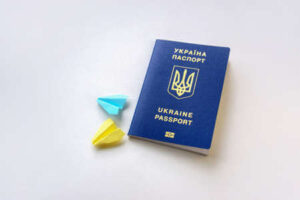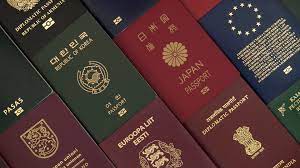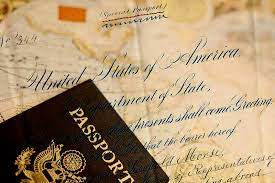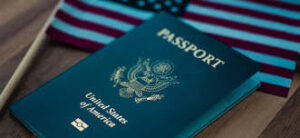Passports play a vital role in international travel, serving as essential documents that grant individuals the freedom to explore the world beyond their own borders. Over time, passports have evolved to incorporate advanced technologies, with one significant development being the introduction of biometric passports. In this article, we will delve into the history and meaning of the biometric passport, shedding light on its significance in modern travel.
This article will cover a wide range of topics:
- Evolution of Passports
- What is a Biometric Passport?
- History of Biometric Passports
- The Power of Biometric Passports
- How to Obtain a Biometric Passport
- Tips for Traveling with a Biometric Passport
Evolution of Passports

Emergence of modern passports and their purpose
Passports have played a significant role in facilitating international travel and ensuring the security of nations. As global mobility increased, the need for standardized identification documents became apparent. Modern passports emerged as a solution to address the challenges of verifying identity and nationality.
Transition from handwritten documents to standardized passports
As travel became more commonplace, countries recognized the need for a universal identification document. The first modern passports emerged in the early 20th century, replacing handwritten letters with standardized booklets containing essential information such as personal details and travel records. This shift ensured consistency and improved border control processes.
Role of passports in ensuring identity and nationality
Modern passports serve as proof of identity and nationality, granting individuals the right to cross borders and return to their home country. They provide a sense of security and assurance to travelers and play a crucial role in safeguarding national borders and regulating international movement.
Introduction of biometric passports as a technological advancement
With the rapid advancement of technology, biometric passports revolutionized the concept of identification documents. Biometrics, such as fingerprints, facial recognition, and iris scans, were introduced to enhance security and accuracy. Well, Biometric data is stored on a microchip embedded in the passport, enabling automated identity verification at immigration checkpoints. This technological advancement significantly reduces the risk of identity fraud and ensures a higher level of security.
Development of biometric technology for identity verification
Advancements in technology paved the way for the introduction of biometric features in passports. Biometrics, such as fingerprints, facial recognition, and iris scans, offer a unique and reliable method of verifying an individual’s identity. These features provide a higher level of security and make it more challenging for fraudulent activities.
Incorporation of biometric features into passports

Transition from machine-readable passports to biometric passports
Machine-readable passports, introduced in the 1980s, utilized optical character recognition technology to expedite the reading and processing of passport information. However, they still relied on visual inspections, leaving room for potential security breaches. The transition to biometric passports marked a significant milestone in passport technology. The incorporation of biometric data adds an extra layer of security, making it more challenging for unauthorized individuals to gain access. Biometric passports not only enhance security but also streamline border control procedures, reducing waiting times and improving overall travel experiences.
Advantages of machine-readable passports
Machine-readable passports introduced in the 1980s featured optical character recognition technology that made passport reading and data entry more efficient. However, they still relied on visual inspections and were susceptible to identity fraud.
Introduction of biometric data in passports for enhanced security
Biometric passports represent the latest advancement in travel document technology. The inclusion of biometric data adds an extra layer of security, making it harder for unauthorized individuals to gain access. Biometric features allow for reliable identity verification and offer governments and travelers increased confidence in the integrity of the passport system.
What is a Biometric Passport?
It is easy to understand biometric passport meaning. Biometrics for passport refers to the measurement and analysis of unique physical or behavioral characteristics of individuals. Biometric features are used to accurately identify and verify the identity of a person. In the context of passports, biometric data is collected and stored digitally, allowing for efficient and secure identity verification at immigration checkpoints.
Types of biometric features used in passports:
- Facial recognition: This technology analyzes facial characteristics to establish identity.
- Fingerprint scans: The unique patterns on an individual’s fingertips are scanned and stored for identification purposes.
- Iris scans: The patterns in the colored part of the eye, known as the iris, are captured and utilized for identification.
- Other biometric features: Some passports may also include features such as voice recognition or palm prints, adding an extra layer of security.
Description of biometric features used in passports

Benefits and advantages of biometric passports
The introduction of biometric passports brings several benefits. Firstly, they enhance security by making it extremely difficult to forge or tamper with biometric data. This significantly reduces the risk of identity theft and passport fraud. Secondly, biometric passports expedite the immigration process, as automated systems can quickly verify the traveler’s identity without the need for manual checks. This leads to shorter wait times and improved efficiency at border control checkpoints.
How biometric data is stored and protected
Biometric data is stored in a secure microchip embedded within the passport. This chip passport is tamper-proof and encrypted to prevent unauthorized access. The data is protected with advanced encryption algorithms, ensuring the privacy and integrity of the stored biometric information. The information stored on the biometric chip on Passport is only accessible through authorized reading devices at immigration checkpoints, making it highly secure and reliable.
History of Biometric Passports
Several countries played a significant role in pioneering the implementation of biometric passports. The United States, in collaboration with its partners, initiated the use of biometric technology in biometric travel documents to enhance security measures. Well, Other countries at the forefront of biometric passport Sign include the United Kingdom, Germany, Australia, and Japan. These nations recognized the potential of biometrics in combating identity fraud and strengthening border control.
Timeline of significant milestones in biometric passport history
- 1998: Malaysia becomes the first country to introduce a biometric passport, incorporating a Passport fingerprint template.
- 2003: The United States introduces the Electronic Passport (ePassport) with embedded chips containing biometric data.
- 2006: The International Civil Aviation Organization (ICAO) establishes standards for biometric passports, facilitating global interoperability.
- 2010: The European Union mandates the use of biometric passports among its member states.
- 2015: The ePassport becomes the global standard, with over 120 countries issuing biometric passports.
- 2019: ICAO introduces the Next Generation Passport specifications, including additional biometric features.
Adoption and standardization by international organizations

Statistics and data showcasing the global prevalence of biometric passports
According to ICAO, as of [insert latest data], over [insert number] countries have implemented biometric passports. This widespread adoption reflects the global recognition of the importance of biometrics in enhancing security and identity verification. Biometric passports have become the norm, with millions of travelers benefiting from their increased efficiency and enhanced security features. The usage of biometric passports continues to expand, with more countries recognizing the value of this technology in safeguarding borders and ensuring the integrity of travel documents.
The Power of Biometric Passports
Visa-free travel is a significant advantage for holders of biometric passports. Many countries have established visa exemptions or visa waiver programs, allowing passport holders to enter without obtaining a visa beforehand. These programs streamline travel processes, reduce administrative burdens, and promote tourism and business exchanges. Biometric passports play a crucial role in facilitating this seamless travel experience, as they provide enhanced security features and reliable identification verification.
One more important thing to consider when it comes to passports and traveling around Europe is new ETIAS regulations, which is set to be launched in late 2025. ETIAS stands for European Travel Information and Authorization System.
Comparison of visa-free travel opportunities for holders of biometric passports
Compared to non biometric passports, biometric passports offer broader visa-free travel opportunities. Biometric passports are recognized and accepted by an increasing number of countries worldwide, granting holders greater mobility and convenience. With biometric passports, travelers can explore numerous destinations without the need for visa applications, saving time and effort.
Statistics and data on the number of visa-free countries for biometric passport holders
According to recent data, holders of biometric passports enjoy access to an extensive network of visa-free countries. On average, biometric passport holders can travel to more than [insert number] countries without a visa. This extensive list of visa-free destinations continues to expand as more countries adopt biometric technology and strengthen their diplomatic relationships.
Benefits of visa-free travel for Canadian travelers to Europe

How to Obtain a Biometric Passport
Obtaining a biometric passport in Canada is a straightforward process that ensures secure and efficient travel. To apply for a biometric passport, Canadian citizens need to follow a specific set of steps outlined by Passport Canada, the government agency responsible for passport issuance.
Step-by-step guide on applying for a biometric passport
- Gather the required documents: Applicants must provide proof of Canadian citizenship, such as a birth certificate or previous passport, along with supporting identification documents.
- Complete the application form: Fill out the passport application form accurately, providing all necessary personal information.
- Get your photo taken: Visit a designated facility to have your biometric photo captured according to the specifications provided by Passport Canada.
- Submit the application: Submit your completed application form, supporting documents, and the appropriate fee to the nearest passport office or Service Canada location.
Documentation and biometric passport requirements needed for passport applications
When applying for a biometric passport, you will need to provide documents to prove your Canadian citizenship, such as a birth certificate, certificate of citizenship, or previous passport. Well, Additionally, you will need to present valid identification, such as a driver’s license or provincial identification card. It’s important to ensure that all documents meet the specified passport biometrics requirements and are in good condition.
Processing time and associated fees
The processing time for biometric passport applications varies depending on factors such as the season, location, and application volume. Typically, standard processing takes approximately four to six weeks, while expedited processing can take two to three weeks for an additional fee. The fees for biometric passports also vary depending on the applicant’s age and the type of passport requested. It’s advisable to check the current fees and processing times on the official Passport Canada website before submitting your application.
Tips for Traveling with a Biometric Passport

As mentioned above, ETIAS is going to change the way people travel to Europe. You can check additional ETIAS travel information on this website. From 2025, the EU will launch the ETIAS system, requiring Canadian citizens traveling to Europe to have a valid ETIAS authorization upon arrival at the EU border.
Precautions to take while traveling to avoid passport-related issues
- Keep your passport secure: Carry your passport in a secure and concealed location, such as a money belt or a pouch worn under your clothing. Avoid leaving it unattended or in easily accessible bags.
- Make copies of your passport: Take photocopies or digital scans of your passport and store them separately from your physical passport. This will serve as a backup in case your passport gets lost or stolen.
- Be cautious of scams: Be vigilant of scams targeting tourists, such as passport theft schemes or individuals posing as authorities. Only provide your passport when necessary, such as during border crossings or official biometric document meaning checks.
Guidance on what to do in case of a lost or stolen passport abroad
Losing your passport while traveling can be a stressful situation, but it’s important to remain calm and take immediate action. Here are the steps to follow:
- Report the loss or theft: Contact the local police to report the incident and obtain a copy of the police report, as it may be required for passport replacement.
- Contact the nearest embassy or consulate: Inform the Canadian embassy or consulate about the loss or theft of your passport. They will guide you through the process of obtaining an emergency travel document or temporary passport.
- Provide necessary documents: Prepare any required documents, such as identification, proof of citizenship, and a passport photo, to facilitate the replacement process.
Useful resources and contact information for Canadian travelers in need of assistance
As a Canadian traveler, it’s essential to have access to relevant resources and contact information for assistance while abroad. Here are some useful resources to keep in mind:
- Government of Canada travel website: Visit the official travel website for up-to-date travel advisories, consular services information, and emergency contact details.
- Registration of Canadians Abroad: Consider registering with the Registration of Canadians Abroad service to receive important updates and assistance in case of emergencies.
- Emergency contact numbers: Save the contact information for the nearest Canadian embassy or consulate, as well as the local emergency services hotline, in your phone or written down for easy access.
Conclusion
In conclusion, the new biometric passport page has revolutionized the world of travel, enhancing security measures and streamlining the identification process. With its embedded chip and biometric features, the biometric chip passport ensures a higher level of accuracy and authenticity in verifying one’s identity. Well, The biometric page of passport, equipped with fingerprint scans, iris recognition, and facial biometrics, provides an added layer of protection against identity fraud and unauthorized access. As countries continue to adopt and standardize biometric meaning passports, travelers can benefit from visa-free travel opportunities and enjoy the convenience of streamlined border control procedures. It is important to understand the biometric e passport requirements and safeguard this valuable document, as it plays a crucial role in international travel. Embrace the power of the EU biometric passport and embark on your global adventures with confidence and peace of mind. Now you know what is the meaning of biometric passport.
